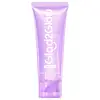What's inside
What's inside
 Key Ingredients
Key Ingredients

 Benefits
Benefits

 Concerns
Concerns

 Ingredients Side-by-side
Ingredients Side-by-side

Water
Skin ConditioningButylene Glycol
HumectantSodium Myristoyl Glutamate
CleansingSorbitol
HumectantSodium Lauroyl Glutamate
Sodium Methyl Cocoyl Taurate
CleansingCocamide DEA
EmulsifyingMyristic Acid
CleansingSodium Chloride
MaskingLauric Acid
CleansingPEG-40
HumectantHydrogenated Castor Oil
EmollientGlyceryl Stearate
EmollientPEG-100 Stearate
Hydroxyacetophenone
AntioxidantPolyglycerin-6
HumectantCitrus Paradisi Peel Oil
MaskingCitrus Aurantium Dulcis Peel Oil
MaskingMoringa Oil/Hydrogenated Moringa Oil Esters
Skin ConditioningGlycerin
HumectantArbutin
AntioxidantPhytic Acid
Sodium Hyaluronate
HumectantCeramide AP
Skin Conditioning1,2-Hexanediol
Skin ConditioningAngelica Polymorpha Sinensis Root Extract
Skin ConditioningBiosaccharide Gum-4
Skin ConditioningSodium Acetylated Hyaluronate
HumectantBletilla Striata Root Extract
Skin ConditioningMorus Alba Bark Extract
Skin ConditioningPaeonia Albiflora Root Extract
Skin ConditioningAmpelopsis Japonica Root Extract
Skin ConditioningAtractylodes Macrocephala Root Extract
Skin ConditioningPerilla Frutescens Leaf Extract
MaskingPoria Cocos Extract
Skin ConditioningSyringa Oblata Bark/Leaf Powder
AbrasivePhenoxyethanol
PreservativeMoringa Oleifera Seed Extract
Skin ConditioningDisodium Phosphate
BufferingCitric Acid
BufferingHydroxypropyltrimonium Hyaluronate
Methylparaben
PreservativeWater, Butylene Glycol, Sodium Myristoyl Glutamate, Sorbitol, Sodium Lauroyl Glutamate, Sodium Methyl Cocoyl Taurate, Cocamide DEA, Myristic Acid, Sodium Chloride, Lauric Acid, PEG-40, Hydrogenated Castor Oil, Glyceryl Stearate, PEG-100 Stearate, Hydroxyacetophenone, Polyglycerin-6, Citrus Paradisi Peel Oil, Citrus Aurantium Dulcis Peel Oil, Moringa Oil/Hydrogenated Moringa Oil Esters, Glycerin, Arbutin, Phytic Acid, Sodium Hyaluronate, Ceramide AP, 1,2-Hexanediol, Angelica Polymorpha Sinensis Root Extract, Biosaccharide Gum-4, Sodium Acetylated Hyaluronate, Bletilla Striata Root Extract, Morus Alba Bark Extract, Paeonia Albiflora Root Extract, Ampelopsis Japonica Root Extract, Atractylodes Macrocephala Root Extract, Perilla Frutescens Leaf Extract, Poria Cocos Extract, Syringa Oblata Bark/Leaf Powder, Phenoxyethanol, Moringa Oleifera Seed Extract, Disodium Phosphate, Citric Acid, Hydroxypropyltrimonium Hyaluronate, Methylparaben
Water
Skin ConditioningPotassium Cocoyl Glycinate
Acrylates/Steareth-20 Methacrylate Crosspolymer
Sodium Lauroamphoacetate
CleansingVaccinium Angustifolium Fruit Extract
Skin ProtectingPotassium Cocoate
EmulsifyingCeramide EOP
Skin ConditioningCeramide Ng
Skin ConditioningCeramide NP
Skin ConditioningCeramide As
Skin ConditioningCeramide AP
Skin ConditioningSodium Chloride
MaskingGlycosyl Trehalose
Emulsion StabilisingPotassium Hydroxide
BufferingCitric Acid
BufferingHydrogenated Starch Hydrolysate
HumectantLauryl Hydroxysultaine
CleansingCaprylyl Glycol
EmollientDisodium EDTA
Aroma
Phenoxyethanol
PreservativeWater, Potassium Cocoyl Glycinate, Acrylates/Steareth-20 Methacrylate Crosspolymer, Sodium Lauroamphoacetate, Vaccinium Angustifolium Fruit Extract, Potassium Cocoate, Ceramide EOP, Ceramide Ng, Ceramide NP, Ceramide As, Ceramide AP, Sodium Chloride, Glycosyl Trehalose, Potassium Hydroxide, Citric Acid, Hydrogenated Starch Hydrolysate, Lauryl Hydroxysultaine, Caprylyl Glycol, Disodium EDTA, Aroma, Phenoxyethanol
 Reviews
Reviews

Ingredients Explained
These ingredients are found in both products.
Ingredients higher up in an ingredient list are typically present in a larger amount.
Ceramide AP is a type of Ceramide.
Ceramides are intercellular lipids naturally found in our skin that bonds dead skin cells together to create a barrier. Having a strong skin barrier leads to more firm and hydrated skin.
They are known for their ability to hold water and thus are a great ingredient for dry skin. By bolstering the skin ceramides act as a barrier against irritating ingredients. This can help with inflammation as well.
If you would like to eat ceramides, sweet potatoes contain a small amount.
Read more about other common types of ceramides here:
Ceramide NP
Ceramide EOP
Citric Acid is an alpha hydroxy acid (AHA) naturally found in citrus fruits like oranges, lemons, and limes.
Like other AHAs, citric acid can exfoliate skin by breaking down the bonds that hold dead skin cells together. This helps reveal smoother and brighter skin underneath.
However, this exfoliating effect only happens at high concentrations (20%) which can be hard to find in cosmetic products.
Due to this, citric acid is usually included in small amounts as a pH adjuster. This helps keep products slightly more acidic and compatible with skin's natural pH.
In skincare formulas, citric acid can:
While it can provide some skin benefits, research shows lactic acid and glycolic acid are generally more effective and less irritating exfoliants.
Most citric acid used in skincare today is made by fermenting sugars (usually from molasses). This synthetic version is identical to the natural citrus form but easier to stabilize and use in formulations.
Read more about some other popular AHA's here:
Learn more about Citric AcidPhenoxyethanol is a preservative that has germicide, antimicrobial, and aromatic properties. Studies show that phenoxyethanol can prevent microbial growth. By itself, it has a scent that is similar to that of a rose.
It's often used in formulations along with Caprylyl Glycol to preserve the shelf life of products.
Chances are, you eat sodium chloride every day. Sodium Chloride is also known as table salt.
This ingredient has many purposes in skincare: thickener, emulsifier, and exfoliator.
You'll most likely find this ingredient in cleansers where it is used to create a gel-like texture. As an emulsifier, it also prevents ingredients from separating.
There is much debate on whether this ingredient is comedogenic. The short answer - comedogenic ratings don't tell the whole story. Learn more about comegodenic ratings here.
The concensus about this ingredient causing acne seems to be divided. Research is needed to understand if this ingredient does cause acne.
Scrubs may use salt as the primary exfoliating ingredient.
Learn more about Sodium ChlorideWater. It's the most common cosmetic ingredient of all. You'll usually see it at the top of ingredient lists, meaning that it makes up the largest part of the product.
So why is it so popular? Water most often acts as a solvent - this means that it helps dissolve other ingredients into the formulation.
You'll also recognize water as that liquid we all need to stay alive. If you see this, drink a glass of water. Stay hydrated!
Learn more about Water